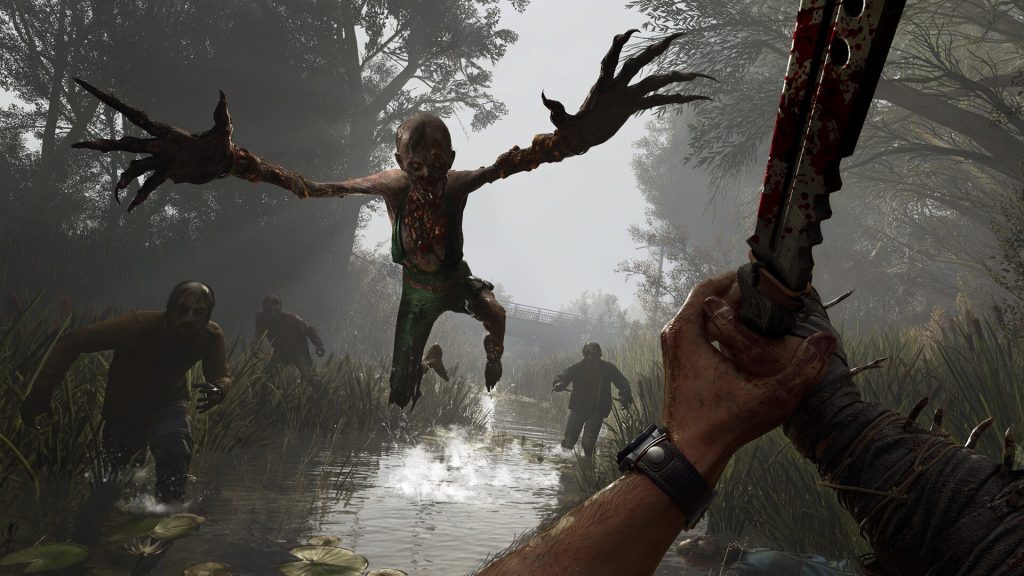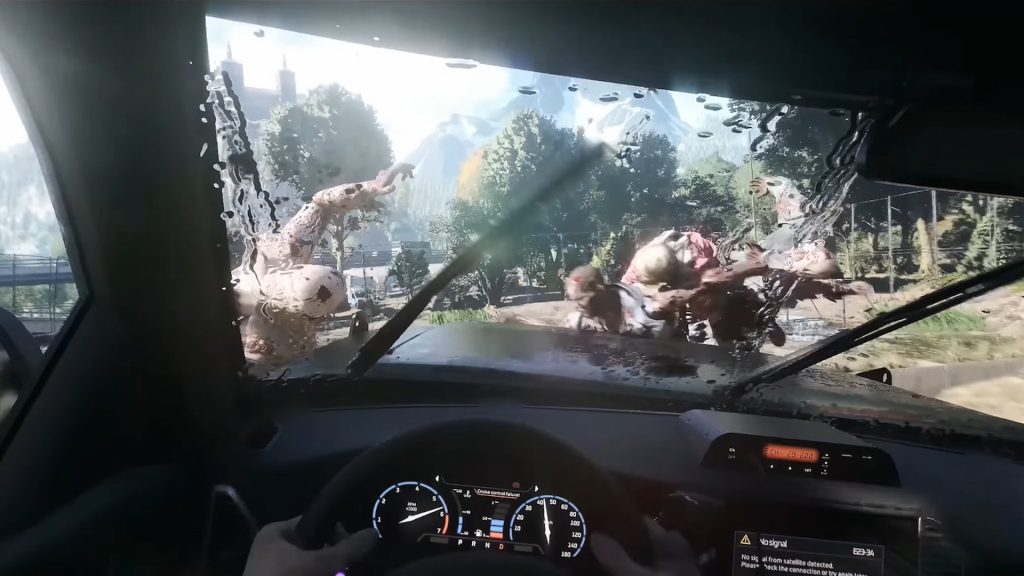Dying Light: The Beast vs Dying Light 2 – What’s Changing?
Initially intended to be a mere expansion to Dying Light 2, The Beast has slowly transformed into its own stand-alone game. And after going through the previews and footage, it’s abundantly clear this has the content and value of a stand-alone product. But why purchase a pared-down experience like The Beast when Dying Light 2 is larger in scope with a discounted price tag? Well, there are a lot of reasons. Here are just 15 of the biggest differences between Dying Light: The Beast and its predecessor Dying Light 2.
From Urban Rooftops to Rural Woods
A good number of things differentiate The Beast from its predecessor, but chief among them are the environments and locale. Dying Light 2’s bright, sprawling concrete jungle is a thing of the past. The Beast takes a much darker fork in the road, placing players in the spooky Castor Woods, a rural environment far away from the colorful cityscape of Villedor.
Smaller, Denser Open World
Since The Beast was initially poised to be an expansion, its size was always going to be dwarfed by Dying Light 2. That is still the case despite its status as a stand-alone game; however, this more compact density is for its own benefit. The smaller map not only allows greater focus and time spent on bespoke asset creation and environmental details, but more distinct biomes that both feel and play differently.
More Varied Environments

One of my favorite aspects of dense, compact game worlds is the kind of variety they often exhibit. The Beast is taking a handcrafted approach to its environments. One sharp contrast we see right away is the amount of unique biomes within Castor Woods. There’s a proper township populated with vine-covered brick buildings, some swamplands, something that looks like a train graveyard, and of course the dark heart of the zombie-infested woods itself. This contrasts sharply with the vast and largely homogenized urban districts within Dying Light 2.
Handcrafted Spaces With Many Explorable Interiors
Complementing this environmental variety are the detailed interiors within Castor Woods. Yes, there’s still quite a bit of architecture to explore, despite the more rural setting. Dying Light 2 drew praise for the number of buildings that could be explored. Though feeling copy/pasted at times, the sensation that almost every building was enterable just added to the immersion. The Beast takes this to the next level with way more bespoke interiors and handcrafted spaces. The game’s director has been on record saying that around 98% of structures can be entered. Some of the structures mentioned ranged from churches to factories, we can assume both abandoned by anyone sane. The more compact world map allowed the devs to handcraft each interior to make them distinct from one another.
Parkour Stays Grounded and Slick
Because of the vast difference in location, parkour takes a rather substantial shift. In particular, no skyscrapers and less crowded infrastructure. Several areas still allow you to leap from building to building, such as the township, but there’s far more of nature to climb around this time. Parkour is creative, using tree trunks and other intentionally positioned objects, almost akin to the Pennsylvanian forests. Previews of The Beast haven’t shown any of the extreme paraglider or grapple traversal from Dying Light 2’s base game, implicating a more grounded and slick parkour style rooted in nature.
Survival-Horror Focus

Of course, dark woods and rural factories do something else beneficial for the game: survival horror. The Beast is consciously bringing back the gritty atmosphere of the first game and it’s accomplishing this in a number of ways. First, there’s the darker lighting that the forest ambiance allows. You’ll notice environments aren’t overly bright and colorful like they were in Dying Light 2.
Ammunition Is Scarcer
But The Beast does more than just visual horror. You’ll also encounter a scarcity in resources thanks to the locale being more rural and disconnected from infrastructure. Limited weapon durability also contributes to scarcity, though in The Beast (like Dying Light 2), players can repair and craft weapons. Let’s just hope the designers balanced weapons so it isn’t too irritating or, on the other extreme, overly frictionless.
Nights Are Deadlier and Scarier
The devs have repeatedly emphasized how much more deadly and frightening nighttime is compared to Dying Light 2. Sure, there’s the limited visibility thanks to overgrown trees and absence of artificial light, but the dreaded Volatiles stalk the night to boot, giving chase at the slightest sound or sight of movement. Between the isolated forest setting and the enhanced aggression of the zombies, The Beast is positioned to be the most horror-driven Dying Light game to date.
Different Protagonist
Dying Light 1 fans will either be pleased or annoyed that Kyle Crane returns as The Beast’s protagonist. Yes, that’s right, Aiden Caldwell from Dying Light 2 isn’t the lead anymore. Kyle Crane is back, seeking to take revenge on The Baron who experimented on him. You see, Kyle isn’t the same from his Dying Light 1 days; he’s now part beast, hence the game title.
Beast Mode
[embedded content]
Kyle’s newfound abilities manifest through the aptly termed Beast Mode. Beast Mode is exactly what it sounds like, an Incredible Hulk-esque burst of power letting Kyle rampage through foes with his fists and sheer stature. Beast Mode enables unique kill animations and mounting of larger enemy types as well as a ground pound maneuver for crowd control.
More Gory and Visceral
One of the details that playtesters seem rather unanimous about is the sheer amount of gore and carnage compared to previous games. And you see some of that in the gameplay. Kyle ruthlessly decapitates Volatiles when activating Beast Mode. Zombies now rip and tear and have their own flesh torn apart or blown apart by Kyle’s weapons. In particular, there’s a lot of limb dismemberment compared to Dying Light 2 here.
Leaner Skill Progression
You power up these brutal executions through the new Beast Power skill tree. There are only around five or so visible nodes through this new segment of the tree, but if they’re anything like the decapitation animation, we’re all for it. Beast Powers can be purchased with Beast Points, a detail we know little about at this time. Besides just the Beast Powers, there are also a small number of other nodes in the leaner, and hopefully more significant, skill tree.
Drivable 4×4 Trucks

As a fan of Days Gone, the inclusion of drivable 4×4 trucks really piques my interest. Just from a cursory glance at the driving gameplay, everything looks solid. The first-person dashboard details (third-person cam is also available) look authentic, and the car exhaust has that deep V8 sound that’s oh so satisfying to the ear. From a gameplay standpoint, you can look forward to ramming over zombies while speeding up your rural A-to-B travel time. You can presumably go anywhere on the map with the 4×4, though driving around in a gas-guzzling V8 is incredibly dangerous since enemies will notice and harm you—if you don’t run out of fuel first, that is.
More Linear Story
Another difference from Dying Light 2 is The Beast’s more linear story. Sure, on the gameplay front, the game is wide open, but those branching story decisions from Dying Light 2 won’t be featured here. Expect an unchangeable narrative set more or less in stone.
Focused Runtime
The developers have gone on record saying The Beast’s core story content hovers around the 20-hour mark. Of course, being the open-world title that it is, there are still lots of side activities to explore, perhaps double the amount that the main story consists of. We’re potentially looking at around 50 hours of game here, and with four-player co-op that replayability only increases. Dying Light: The Beast releases as a stand-alone game on September 19 for PC, Xbox Series X/S, and PS5, and for PS4 and Xbox One at a later date. Its $59.99 price point matches its more pared-down runtime.


Comments are closed.